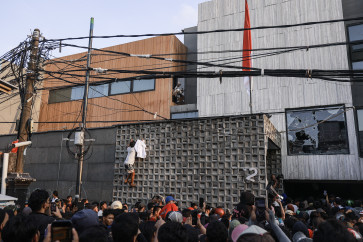Popular Reads
Top Results
Can't find what you're looking for?
View all search resultsPopular Reads
Top Results
Can't find what you're looking for?
View all search resultsBuilding on the past with ‘hanok’ houses
South Korea offers many ways to experience cultural tourism
Change text size
Gift Premium Articles
to Anyone
S
outh Korea offers many ways to experience cultural tourism. One unique and popular way is by staying at a Korean traditional house, called a hanok.
Anywhere from decades to hundreds of years old, a hanok lets guests embrace old Korean culture and get in touch with the way people lived in the past. Retaining old architectural styles and sentiments, a hanok has antique furniture, paper-paste windows and soy jars to enhance the traditional ambiance.
During a stay, guests can also experience various programs, including a tea ceremony, pottery classes and traditional folk games.
A typical hanok is characterized by wooden pillars, mud walls, a wooden floor or porch for temperature control during different seasons and a courtyard or a garden.
A number of the houses are now preserved in specially designated villages in several cities in South Korea.
Hanoks in Seoul
Bukchon Hanok Village in Jongno district in Seoul is home to hundreds of the houses dating back to the Joseon Dynasty, which lasted from the 14th to 19th centuries.
Nestled between two royal palaces — Gyeongbokgung Palace and Changdeokgung Palace, and close to Dongdaemun and Namdaemun Markets, and Jungang High School — many houses in the village operate as cultural centers, guesthouses, restaurants and tea houses.
Seoul Guesthouse is the oldest and largest, with a garden adorned with ancient artifacts. It also has an annex called a sarangchae — for men to study or entertain guests — that offers a view of Inwangsan Mountain and Bukaksan Mountains.
Tea Guesthouse offers indoor and outdoor areas to drink tea and activities. All rooms are made of pine trees and have the traditional under-floor heating called ondol, heated by burning bamboo and yellow soil loess.
At Bukchon Guesthouse, guests can cook Korean dishes, try on traditional hanbok clothing and learn traditional etiquette, while those at Manaedang Guesthouse may try making small portable dining tables — locally called soban — at the guesthouse’s own atelier.
Another cultural center, Rakkojae, serves up Korean food, folk music and folk dance where guests can taste the life of nobleman of ancient South Korea.
Famous place
Today’s most famous hanok are at the 350-year-old Jirye Art Village in Andong and at Jeonju Hanok Village in Jeonju.
Situated in the east of South Korea, guests staying at the houses in the village in Andong can experience making rice cakes and kimchi, the traditional fermented dish made of vegetables with a variety of seasonings.
Those staying at hanok at the village in Jeonju, in the southwest of South Korea, can enjoy the city’s signature dish, bibimbap, served as a bowl of warm white rice, sautéed and seasoned vegetables and chili pepper paste, with additions including a raw or fried egg and sliced meat, usually beef.
In addition to culinary delights, Jeonju Hanok Village also offers invigorating walking tours to numerous heritage sites, including Pungnammun and Gyeonggijeon shrines, Jeondong Cathedral, Crafts Exhibition Hall, Jeonju Treasures Center and the Museum of Traditional Wine.
A stop at teahouses will add excitement of the tour. Gyodong Dawon is the local favorite and is considered to be among the best teahouses in the village. Its yellow tea hwangcha is the most popular, moderately fermented, with a light, clean taste. It is believed to be an effective cold remedy. Wheat crackers served with tea go perfectly, enhancing the pleasure of tea drinking.










